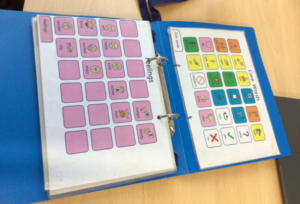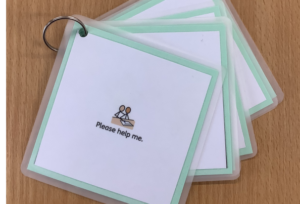Children communicating in different ways
“I’ve been told my child communicates in different ways: What can I do?”
Sometimes, terms like non-verbal, non-speaking, and minimally verbal are used to describe children who don’t use talking as their main form of communication. Everyone communicates in different ways, and not talking doesn’t mean not communicating. This short blog highlights different options for children who may not talk to communicate. While these methods can be helpful for many children, it’s important to seek guidance from your local speech and language therapy service to find the best approach for your child.
What is communication?
Communication is the way people share ideas, feelings or information with each other. We do this by talking or using alternative forms of communication such as gesturing or using symbols or pictures. It’s how we let others know what we’re thinking or feeling.
What is AAC?
AAC stands for augmentative and alternative communication.
- Augmentative = adding something to help or make things easier
- Alternative = a different option or choice
- Communication = sharing ideas, feelings or information with other people
There are two types of AAC, here is some information about the two:
Unaided AAC means using only your body to communicate. This can be things like pointing, making gestures, using facial expressions, or hand signs. You don’t need any special tools or devices—just your body! It helps people share their thoughts when talking is tricky.
We often think of talking as the main way we communicate, however there are lots of other ways we (and our children) communicate too, including:
- Body movement and gestures like turning their head away, pointing or waving, can help children tell you something without talking.
- Facial expressions can show emotions, letting us know when they’re happy, surprised, or upset.
- Sounds and noises such as cooing, laughing, or even grunting, are sounds that can communicate needs or reactions.
- Eye gaze – where a child looks can show you what they are interested in or what they want.
- Signing – signing aims to enhance communication skills. Signing can be used alongside talking, or it can provide an alternative way to communicate for children who aren’t talking.
There are lots of different types of signing systems that can support communication:
- British Sign Language (BSL) – is the most widely used sign language in the UK. It is a fully developed language that incorporates gestures, facial expressions, and body language to communicate.
- Makaton combines signs, symbols, and talking, making it usable by all children, including those who have challenges talking and understanding words. Makaton is often used alongside talking to support understanding and to help children and families communicate effectively even if talking is difficult.
- Signalong is another communication system based on BSL, focusing on supporting understanding through simplified signs.
The other type of AAC is aided. Aided AAC means using tools or devices to help you communicate. Aided AAC could be something simple like a picture card or something more advanced like a tablet that talks. These tools help people share their thoughts and feelings when talking is difficult. Aided AAC may be ‘powered’, meaning it uses a source of electricity, or ‘paper-based’, meaning it does not.
Examples of ‘powered’ AAC may include:
- iPads/tablets using software that can ‘talk’ in words or sentences. The person using it presses buttons or symbols, and the device says the words out loud.

- Single message buttons – small devices that play a recorded message when pressed. You can record one word or phrase, like “help” or “I’m hungry,” and the button says it out loud when pushed.

Examples of ‘paper-based’ AAC may include:
- Alphabet boards – has all the letters on it, and people can point to each letter to spell out words.
- Communication books – a collection of pictures, symbols, or words that someone can point to communicate.

- Picture/symbol cards – images or symbols that represent words or ideas, like a picture of a drink to ask for water. These cards help people communicate by pointing to the one that matches what they want to say.

Always check with a speech and language therapist before introducing any new approach. It’s important to find the right approach for your child, which may involve using a combination of different methods, as there’s no one-size-fits-all solution. All communication is meaningful, no matter what form it takes!
Navigating your child’s speech and language challenges can be difficult but support is available. Below are organisations that offer information and support for individuals using AAC and their families:
- Communication aids and AAC | Disability charity Scope UK
- Types of AAC – Communication Matters
- Communication Access UK – Inclusive communication for all
- Makaton
- ISAAC
- Ace Centre | Charity specialising in AAC & Assistive Technology
- Communication Aids | Electronic Communication Aid | Sequal Trust
- 1Voice
Useful resources
Interested in reading more? Check out some of the websites we referenced when putting this page together:
